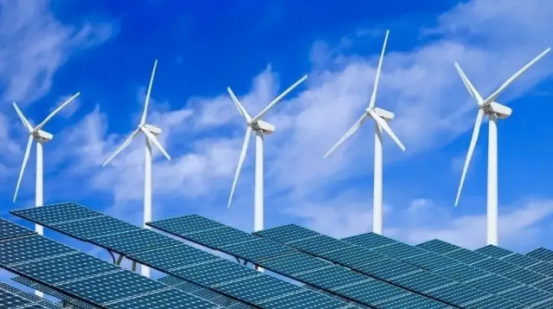
News
The trillion-scale energy storage industry: Is it at a historic turning point?
Release time: 2022-09-30
Source: YiDU Finance (Statement: The article does not represent the views of our company, and it is only for reference.)
With the continuous promotion of the dual carbon goals, the new energy industry has been able to develop rapidly, and the related industries have also entered a new historical stage.
This article focuses on energy storage industry.
What is energy storage? According to Baidu Encyclopedia, energy storage refers to the process of storing energy through media or equipment and releasing it when needed. A simple understanding that it is a big power pack.
Previously, energy storage was synonymous with oil reservoirs, representing the ability of reservoirs to store oil and gas. Now, under the background of double carbon and the development trend of wind power, photovoltaic and other new energy, energy conservation, environmental protection and low carbon have become the essence of the development of all countries. Europe, the United States and Japan regard energy storage as an independent industry, and have issued special supportive policies. Due to the many scenarios of energy storage for household users, commercialization is relatively mature.
In contrast, in China, under the premise of fewer household energy storage scenarios and the lack of energy storage payment mechanism, the commercialization model of the energy storage industry is not yet mature. But this can't stop the new inflection point of domestic energy storage industry.
01 One of the three super tracks of "Carbon Neutralization"
In response to the global climate problem, low carbon and emission reduction have already become a global consensus. China proposes to achieve the dual carbon goals of "carbon peak" and "carbon neutralization" by 2030 and 2060 respectively.
Under this goal, many industries will benefit.
Photovoltaics, new energy vehicles and energy storage are called known as the three super tracks under "carbon neutral". Although both of them are "three big", the performance of the energy storage industry is not as good as that of the photovoltaic and new energy vehicle industries, which have experienced several rounds of explosive growth.
This status has been maintained for several years. Until the first half of this year, with the recovery of the new energy sector, the energy storage index began to rebound. The data shows that since the end of April, the energy storage concept index has increased by more than 60%.
The performance of the capital market is often inseparable from the favorable policies. Since 2022, the policy level has paid great attention to the energy storage industry, and a series of favorable policies have been continuously introduced.
In January, the "Fourteenth Five-Year Plan" for the Implementation of New Energy Storage Development set the development goal of new energy storage;
In April, the Fourteenth Five-Year Plan for Scientific and Technological Innovation in the Energy Field proposed to speed up the strategic and forward-looking key technology tackling of power grids, and support the construction of advanced power grids that adapt to large-scale renewable energy and distributed power friendly grid connection, two-way interaction between source and grid load, and intelligent and efficient;
In June, the Notice on Further Promoting the Participation of New Energy Storage in the Power Market and Dispatching Application pointed out that it is necessary to establish and improve the market mechanism suitable for the participation of energy storage, encourage new energy storage to participate in the power market independently, give play to the advantages of energy storage technology, improve the overall utilization level of energy storage, ensure the reasonable income of energy storage, and promote the healthy development of the industry.
It can be seen that intensive policies have a significant impact on the development of China's new energy storage during the "Fourteenth Five-Year Plan" period.
In addition to top-level design, local implementation rules further accelerated the pace of industry development. In June, 48 local energy storage policies were issued, mainly involving energy storage subsidies, energy storage installation planning, energy storage facility construction, etc.
Jiangxi's "Fourteenth Five-Year Plan" energy development plan proposed that "we should encourage new energy utilization methods such as hydrogen energy and power generation side energy storage, explore the development model of" new energy + energy storage ", reasonably determine the proportion of energy storage configuration, and improve the friendliness of new energy and the ability of power support capacity."
In Futian District, Shenzhen, Guangdong Province, for the electrochemical energy storage projects that have been put into operation and have actually invested more than 1 million yuan, a subsidy of up to 0.5 yuan per kilowatt will be given according to the actual discharge. The support period for each project is 3 years, and the subsidy support for the same project will not exceed 2 million yuan.
Under the favorable policies, the energy storage industry has developed rapidly, and the "new energy + energy storage" project has been rapidly spread across the country.
According to the public statistics, if all the planned projects for new energy storage are in place, the new investment will reach 150 billion yuan in four years based on the average cost of 4 billion yuan per GW of new energy storage.
Trillion track, who’s the winner?
The prediction of Everbright Securities shows that the scale of China's energy storage market will reach RMB 0.45 trillion by 2025 and about RMB 130 million by 2030.
It should be noted that 2030 is only the year when the "carbon peak" goal is achieved. This also means that the energy storage track has broad prospects.
The policy is good enough and the track is wide enough, and the energy storage market, which has been silent for several years, is finally on the "fast track" of development. In 2022, energy storage will become a key track for technology giants and star enterprises.
In the industry, CATL and BYD have already taken the lead in layout and received dividends.
As early as 2011, CATL laid out its energy storage battery business at the beginning of its establishment. Huang Shilin, the former No. 2 figure of CATL (who has now left to start his own business), said when accepting the media that: CATL set two business goals at the beginning of its establishment, one is power battery, the other is energy storage battery.
As the leader of the new energy industry, CATL has continuously laid out the energy storage track by establishing joint ventures or investing in shares in the past 11 years. So far, its revenue on the energy storage side is considerable.
The financial report data of CATL in 2021 shows that its total revenue is 130.356 billion yuan, with a year-on-year growth of 159.06%. Among them, the business revenue of energy storage system was 13.624 billion yuan, with a year-on-year growth of 601.01%, accounting for more than one tenth of the total revenue.
Then look at BYD. In 2008, when BYD Electric Power Research Institute was officially established, it began to focus on the layout of energy storage track. BYD's 2021 financial report shows that its energy storage business is growing significantly with the momentum of new energy development. In terms of rechargeable batteries and photovoltaic business in the energy storage industry, BYD's revenue was about 16.471 billion yuan, up 36.27% year on year.
In recent years, Huawei, EVE Energy and Gotion High Tech have entered the energy storage track. The competition in this track has become extremely fierce.
Since this year, in addition to traditional enterprises, the market has also welcomed many cross-border players.
In March this year, WTECL (Wintime Energy Co., Ltd.) said that it would invest in the construction of energy storage projects and new energy projects in Henan Province together with CYPC(China Yangtze Power Co., Ltd.) and CTG(China Three Gorges Corporation) Henan Branch. Until September 25, as WTECL announced the official establishment of Detai Energy Storage, the cross-border trip of WTECL was officially started.
WTECL is not alone in cross-border energy storage from traditional energy sources.
Also in March this year, Hangzhou Boiler Group changed its name to "Xizi Clean Energy" and adhered to the development strategy of "new energy+energy storage". At the same time, Xizi Clean Energy signed the first energy storage project contract with Shaoxing Green Power Energy, and plans to carry out the green power molten salt storage demonstration project in Tianshi Industrial Park, Binhai Industrial Zone, Keqiao District, Shaoxing City, Zhejiang Province, with a total investment of 191.54 million yuan.
In the same month, Guangdong Shaoneng Group also chose to enter. It signed a framework agreement on cooperation and development of new energy projects with Dashun, and decided to carry out all-round and in-depth strategic cooperation in new energy fields such as photovoltaic, wind power, hydrogen energy, energy storage and energy conservation. Three months later, the cooperation between the two parties came to fruition. Shaoneng Group announced that it planned to establish a joint venture with Dashun Investment, named Shaoguan Ruichu New Energy Investment Co., Ltd., which is mainly engaged in the investment and development of wind power, photovoltaic, energy storage and other projects.
At the same time, some star companies also choose to "run in".
In May this year, Midea Group announced to enter the field of energy storage;
Sany Group, a "construction machinery giant", established Sany Lithium Energy Co., Ltd. in Changsha, Hunan Province, with its business covering battery manufacturing, sales, leasing, energy storage, etc.
In addition, Xiaomi, a mobile phone company, and Huawei announced that they would jointly invest in Beijing WeLion New Energy Technology Co., Ltd. WeLion New Energy focuses on the R&D and production of mixed solid-liquid electrolyte lithium ion batteries and all-solid-state batteries. It is also the only industrialization platform for solid state battery technology in the Clean Energy Laboratory of the Institute of Physics, Chinese Academy of Sciences.
Xiaomi's cross-border business is not limited to this. In September this year, Xiaomi officially released its first outdoor power supply product, officially entering the mobile energy storage market. According to the public information, MIJIA Outdoor Power 1000Pro, mainly for high-end new energy vehicles which adopts "mixed solid liquid electrolyte lithium battery", with a battery capacity of 1022Wh, a density of greater than or equal 500Wh/L, and can be recharged 1000 times.
Commercialization is still a major difficulty
Policy support, star enterprises layout, and the successful examples of CATL and BYD, but does it mean that the track will be prosperous?
Lin Boqiang, president of China Energy Policy Research Institute of Xiamen University, said that under the "dual carbon" goal, domestic optical storage integration projects have achieved rapid development thanks to the continuous support and guidance of policies. However, for enterprises, commercial costs are still a big problem.

Recently, some practitioners of listed companies disclosed to the media that "the company's energy storage project has more than one billion yuan of orders in hand this year, but due to the impact of upstream resource costs, they have been afraid to take orders for the time being." He also said that since last year, the company's optical storage integration business has shown a rapid growth trend, and the cumulative installed capacity of the company in the year has been two or three times that of last year.
Moreover, the double pressures of rising costs and falling gross profit margin of energy storage enterprises are the common problem in the industry, even the CATL is no exception.
In the first half of the year, the revenue of energy storage business of CATL increased by 171.41% year on year, realizing a revenue of 12.736 billion yuan, but at the same time, it faced the challenge of declining gross profit margin. In the first half of 2021, the gross profit rate of the energy storage business of CATL will be 36.6%, while in 2022, the gross profit rate of the energy storage business of the company will drop sharply to 6.43%, down 30% year-on-year.
Compared with battery enterprises, integrators will face greater challenges. Due to the high price of energy storage battery and the large proportion of energy storage battery in integrated system, the profit of energy storage business will also be squeezed to varying degrees due to the impact of cost. Therefore, many energy storage enterprises have shifted their focus to overseas.
Sungrow (Sungrow Power Supply Co., Ltd. ) has previously said that the gross profit of domestic energy storage projects is low, and the company will focus on overseas markets, with the goal of accounting for more than 20% of energy storage in the global market. Similarly, Huabao Xinneng, recently known as "the first energy storage stock", also regards overseas as an important market expansion.
Conclusion
Although the energy storage market is very hot now, a relatively mature business model has not yet been formed, which is one of the reasons why the development of the energy storage industry is not widespread. Perhaps only by solving this difficulty can the industry really enter the "fast lane" of healthy development.
Original link: https://qiye.qizhidao.com/article-hygc/1575713273548902401.html


